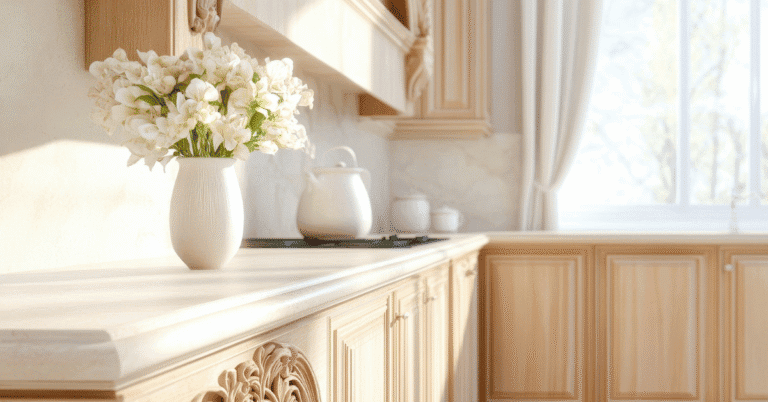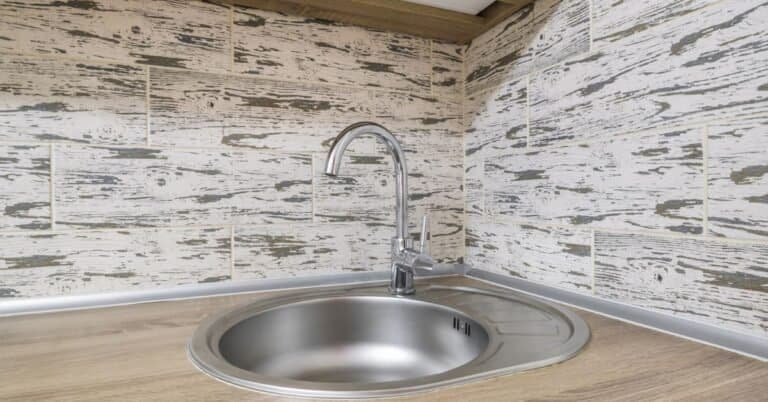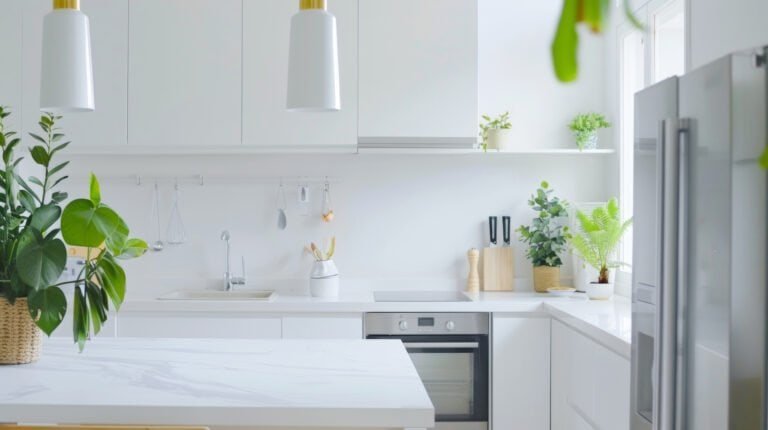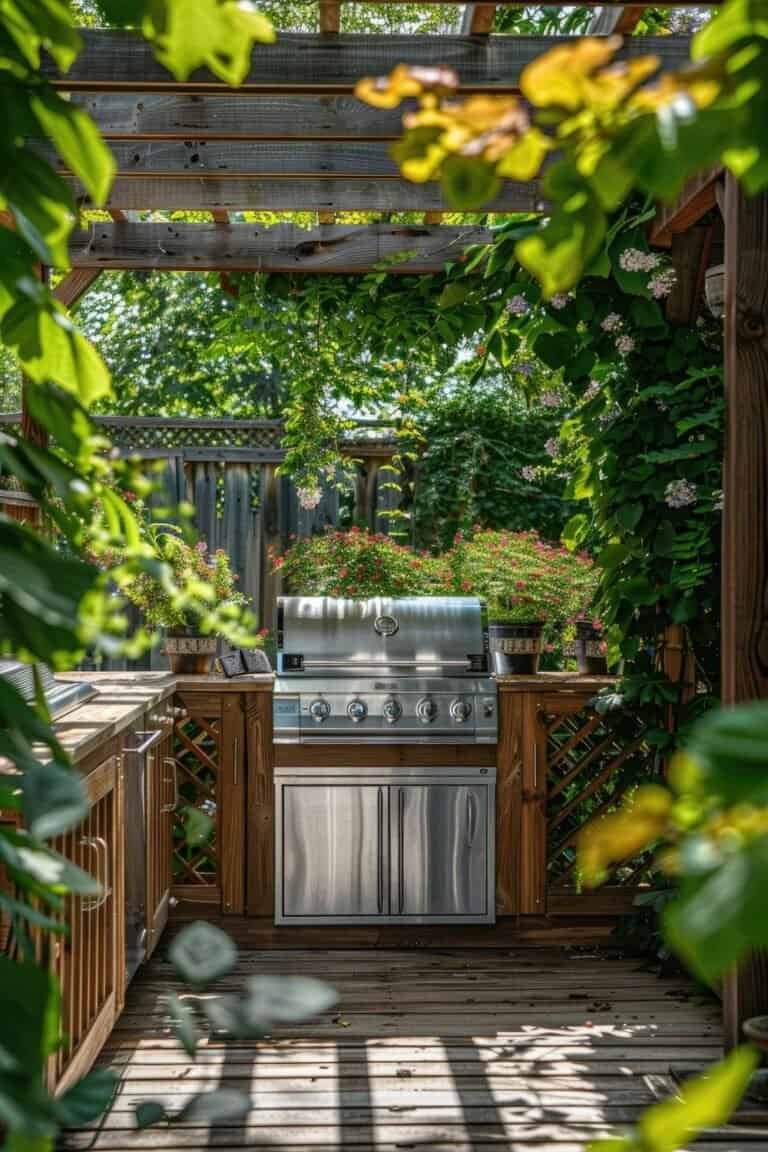This post shows 15 Hacks for Small Kitchen Counter Organization!

Let’s be honest—your kitchen counter looks like a tornado hit it, doesn’t it? Between the coffee maker that never moves, the pile of mail you swear you’ll sort “tomorrow,” and that mysterious gadget you bought on Amazon at 2 AM, your precious counter space has basically vanished. I get it because I’ve been there too, staring at my cluttered counters and wondering how I’m supposed to cook anything when there’s barely room for a cutting board.
Here’s the thing: small kitchens don’t have to mean chaotic counters. You just need to think smarter, not harder. After years of battling my own tiny kitchen and helping friends transform theirs, I’ve discovered 15 game-changing hacks that’ll give you back your counter space and maybe even your sanity. Ready to reclaim your kitchen? Let’s jump in.
15 Hacks for Small Kitchen Counter Organization
1. Go Vertical with Magnetic Magic

Magnetic strips are absolute lifesavers, and I’m not being dramatic here. Mount these bad boys on your wall or under your cabinets, and suddenly your knives, scissors, and metal utensils have a proper home that’s not taking up precious counter real estate.
I installed a 20-inch magnetic strip under my upper cabinet about two years ago, and it’s honestly one of the best $15 I’ve ever spent. My knives stay sharp (no more tossing them in drawers like a caveman), they’re always within reach, and guests always ask where I got it. The key is getting a strong magnetic strip—trust me, you don’t want your chef’s knife taking a dive while you’re cooking.
Pro tip: These strips also work for spice jars with metal lids, small measuring spoons, and even bottle openers. Just make sure you mount them at the right height—you want easy access without bumping your head every time you reach for something. Have you ever tried cooking with a concussion? Yeah, me neither, and I’d like to keep it that way 🙂
2. Create Your Own Pegboard Paradise
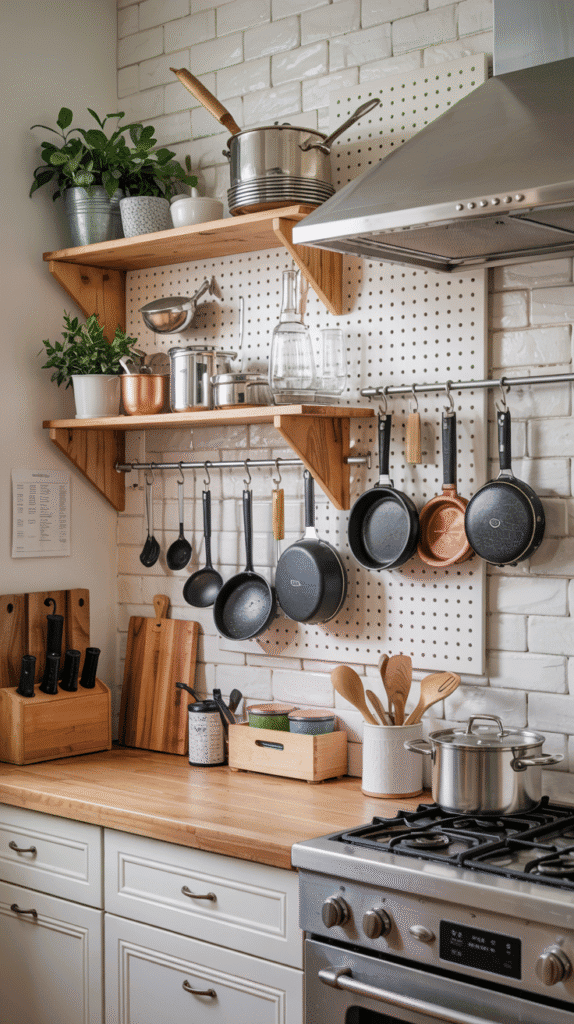
Pegboards aren’t just for garages anymore, people. These versatile organizers can transform any blank wall into a storage powerhouse that’ll make your friends jealous. I’m talking pots, pans, utensils, measuring cups—basically anything with a handle or a hole can find a home here.
The beauty of a pegboard system lies in its flexibility. Need to rearrange things? Just move the hooks around. Got a new gadget? Add another hook. It’s like adult Legos, but way more practical. I set up a 2×3 foot pegboard next to my stove, and it holds about 80% of my cooking tools.
Here’s what I learned the hard way: invest in quality hooks and accessories. Those cheap plastic ones will break faster than your New Year’s resolutions. Go for metal hooks that can actually support the weight of your cast iron skillet. Also, paint your pegboard a fun color—mine’s a deep teal that adds personality to my otherwise boring rental kitchen. Who says organization can’t be Instagram-worthy?
3. Under-Cabinet Hanging Baskets are Game Changers
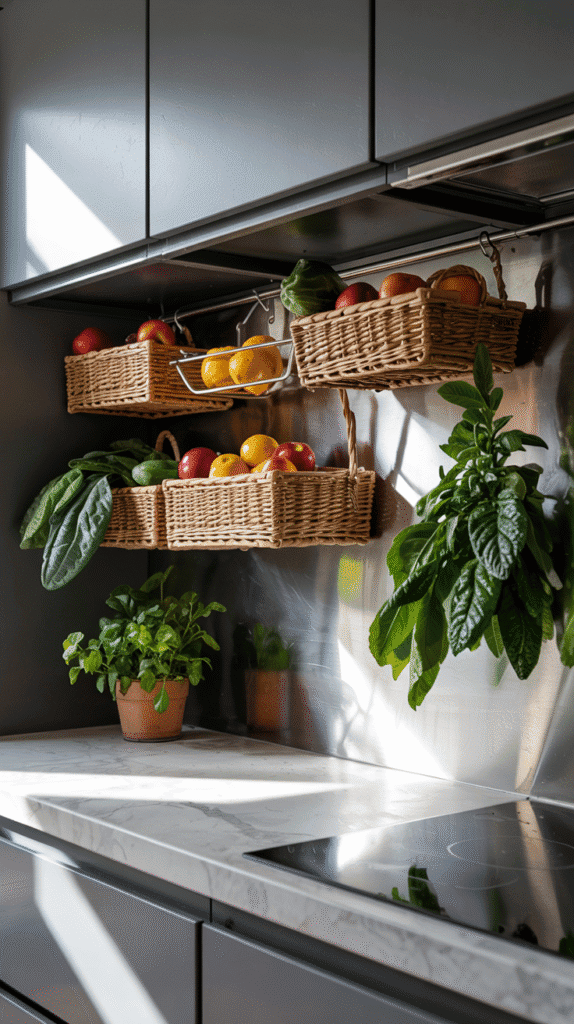
This hack blew my mind when I first discovered it. Under-cabinet hanging baskets create storage space in areas you probably never even considered. I use mine for fruits and vegetables that don’t need refrigeration—onions, potatoes, bananas, you name it.
The installation is surprisingly simple, even for someone like me who once assembled an IKEA bookshelf upside down (don’t ask). Most systems just require a few screws into the bottom of your upper cabinets. Make sure you measure first though—you don’t want baskets hanging so low that they become head-bonkers.
I currently have three wire baskets under my cabinets: one for onions and garlic, one for bananas and apples, and one for kitchen towels and oven mitts. The best part? Everything stays fresh longer because air can circulate properly, unlike when I used to stuff everything in drawers like some kind of produce hoarder. Your fruits and veggies will thank you, and so will your counters.
4. Corner Shelves: The Forgotten Real Estate

Corners are the most underutilized spaces in kitchens, yet they’re perfect for tiered shelving that can hold tons of small items. I’m talking spices, oils, vinegars, small appliances—all those things that usually crowd your counters because you use them regularly.
When I say tiered, I mean those spinning lazy Susan-style shelves or the stepped ones that look like tiny staircases. Both work brilliantly, but I prefer the spinning ones because everything stays accessible. There’s nothing worse than having to move five bottles of oil just to reach the vanilla extract hiding in the back.
The key is choosing shelves that actually fit your corner dimensions. Measure twice, buy once—trust me on this. I made the mistake of eyeballing it once and ended up with a shelf that was too big, turning my corner into an obstacle course. Now I keep my most-used spices and cooking oils right there, spinning away like a lazy Susan disco party every time I cook.
5. Over-the-Sink Storage Solutions

Your sink area is prime real estate that’s probably going to waste right now. Over-the-sink cutting boards and colanders are brilliant because they create extra prep space exactly where you need it most—right where you’ll be washing and prepping your ingredients.
I have an extendable over-sink cutting board that’s become my favorite kitchen tool. It slides out when I need extra chopping space and tucks away when I don’t. The best part? All the veggie scraps fall right into the sink instead of all over my counters. It’s like having a built-in compost chute.
Colanders that fit over your sink are equally genius. Instead of taking up cabinet space, they hang right where you’ll use them most. Some even come with adjustable arms that fit different sink sizes. IMO, this is one of those “why didn’t I think of that” inventions that makes you wonder how you ever lived without it. Just make sure your sink can handle the weight when the colander’s full of pasta water—learned that one the hard way :/
6. Rolling Carts: Your Mobile Command Center
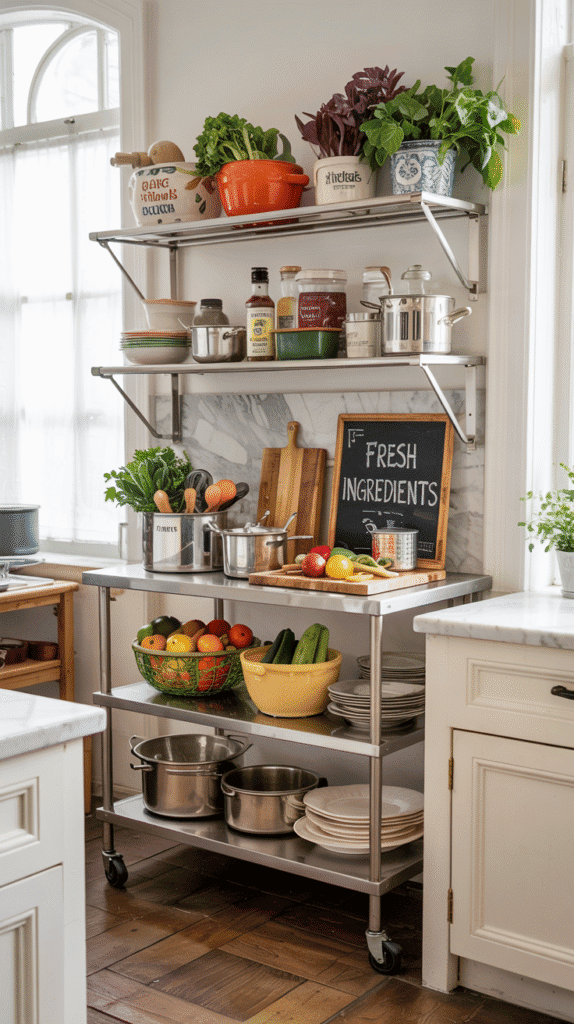
Rolling kitchen carts are like having a portable kitchen island that you can move wherever you need it. I use mine as extra prep space when I’m cooking big meals, and it doubles as a bar cart when I’m entertaining. Talk about multitasking!
The secret is choosing a cart with multiple levels and built-in storage. Mine has three tiers: the top for prep work, the middle for frequently used ingredients and tools, and the bottom for heavier items like my stand mixer attachments. The wheels lock, so it stays put when I’m chopping, but I can easily roll it out of the way when I need floor space.
Here’s a pro tip: get a cart that’s the same height as your counter. This way, you can use it as an extension of your workspace rather than a separate surface. I keep mine stocked with cutting boards, mixing bowls, and measuring tools, so it’s basically a mobile baking station. When friends come over for cooking sessions, I roll it right up to wherever we’re working. It’s like having a sous chef that never complains about overtime.
7. Appliance Garages: Hide the Chaos

Appliance garages sound fancy, but they’re really just cabinet spaces designed to hide your small appliances while keeping them accessible. Think of them as parking spots for your coffee maker, toaster, and blender—all the stuff that usually camps out on your counters permanently.
I built a simple one using a deep cabinet with a roll-up door (okay, fine, I hired someone to build it because I value my fingers). Now my coffee maker lives there, plugged in and ready to go, but completely hidden when I’m not using it. The garage has an outlet inside, so I don’t have to unplug anything—I just roll up the door, make my coffee, and roll it back down.
If you’re not ready for a full renovation, you can create a temporary appliance garage using a large cabinet or even a decorative screen. The key is keeping frequently used appliances plugged in and accessible while hiding the visual clutter. Your counters will look cleaner, and your small appliances won’t get dusty from sitting out all the time. Win-win situation, people.
8. Smart Cutting Boards with Storage
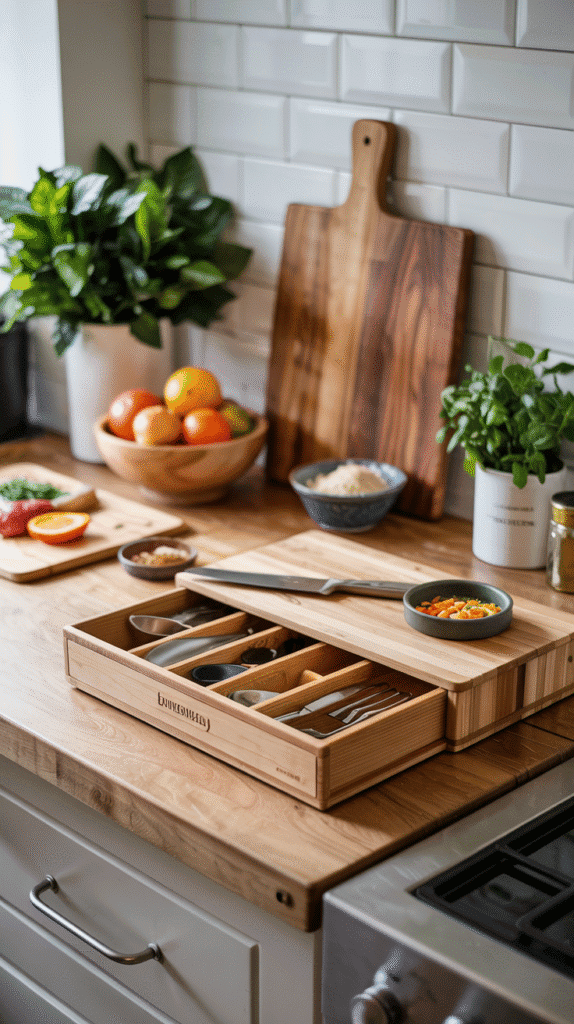
Regular cutting boards are so last century. Cutting boards with built-in storage compartments are where it’s at. These clever designs have little drawers or slots that hold your knives, keep your prep organized, and sometimes even include measuring tools.
I have one with four small compartments that slide out from the sides. When I’m prepping vegetables for stir-fry, each compartment holds a different veggie, keeping everything organized and preventing the “where did I put the diced onions?” panic. Some versions even have built-in scales, which is perfect for baking when precision matters.
The bamboo ones are my favorite because they’re naturally antimicrobial and look great even when they’re sitting out. Plus, bamboo is easier on your knife blades than plastic or glass. Just remember to hand-wash these fancy cutting boards—the storage compartments don’t always play nice with dishwashers. But honestly, the convenience is worth the extra 30 seconds of hand-washing.
9. Stackable Container Systems

Forget about random mismatched containers cluttering your counters. Stackable storage containers that double as serving dishes are the organizational holy grail. I’m talking about those sleek glass or BPA-free plastic containers that look good enough to go from storage to table.
My system includes various sizes that all nest together when empty, saving tons of cabinet space. When I meal prep on Sundays, I use them to store prepped ingredients, and they stack neatly in my fridge. When I’m entertaining, the same containers become serving bowls for snacks and sides. It’s like having dishware that works overtime.
The trick is choosing containers with airtight lids that actually seal properly. Nothing’s worse than opening a container to find stale crackers or soggy vegetables. I learned this lesson after ruining a batch of homemade granola because I cheaped out on containers. Now I invest in quality sets that keep everything fresh and look presentable enough for company. Your future self will thank you when you’re not throwing away spoiled food every week.
10. Kitchen Islands with Hidden Storage
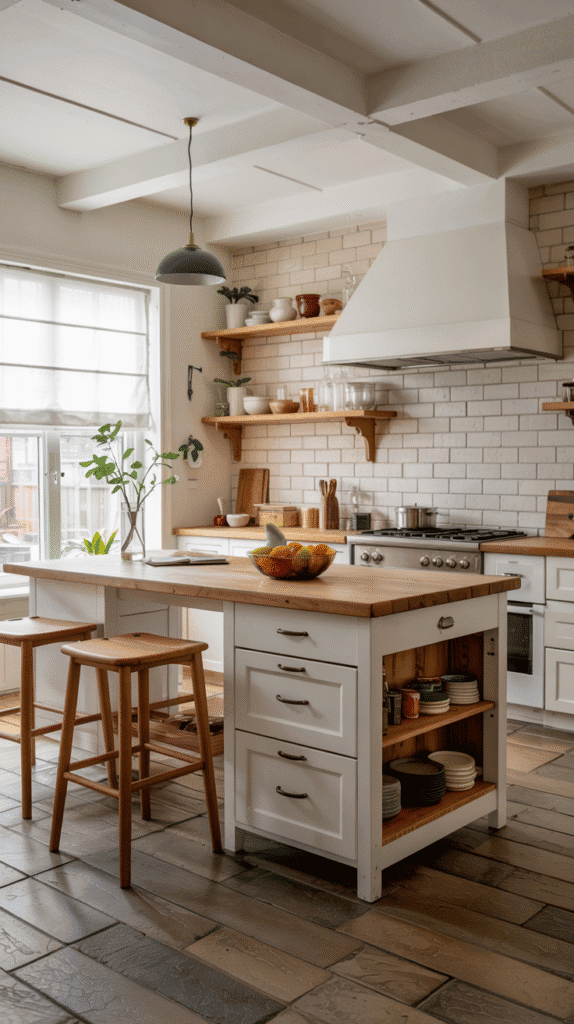
If you have the space and budget for a kitchen island, make sure it earns its keep with tons of hidden storage. I’m not talking about those basic islands that are just fancy tables—I mean the ones with drawers, cabinets, and maybe even a wine rack built in.
My island has deep drawers on both sides, perfect for storing pots, pans, and serving dishes that I don’t use daily. The end caps have narrow cabinets that hold baking sheets and cutting boards vertically—no more digging through stacks to find the right size. There’s even a pull-out trash bin, which keeps my kitchen looking cleaner and smelling better.
The top serves as extra prep space, but here’s the genius part: the overhang creates a breakfast bar where people can sit and chat while I cook. It’s become the social hub of my kitchen, and all that storage means my actual counters stay clear for cooking. FYI, if you’re considering an island, make sure you have at least 36 inches of clearance on all sides—trust me, you don’t want to be squeezing through tight spaces while carrying hot pans.
11. Pull-Out Cabinet Drawers

Deep cabinets are great for storage capacity but terrible for accessibility—until you add pull-out drawers. These game-changing organizers bring everything in your deep cabinets right to you, no more crawling around on hands and knees to find that one pot hiding in the back.
I installed soft-close pull-out drawers in my lower cabinets, and it’s honestly changed my cooking life. My heavy Dutch oven used to live in the back corner where I’d forget about it for months. Now it slides out effortlessly whenever I need it. The soft-close feature means no more slamming drawers and waking up the neighbors during early morning cooking sessions.
The installation isn’t as scary as it looks—most systems are designed for DIY installation with just a screwdriver and some patience. Measure your cabinet interior carefully though, because these drawers need to fit precisely to work properly. I made the mistake of buying before measuring and had to return the first set. Learn from my impatience, people.
12. Inside Cabinet Door Organizers

The inside of your cabinet doors is prime real estate that most people completely ignore. Door-mounted organizers can hold spices, cleaning supplies, cutting boards, baking sheets—basically any flat or small items that usually create counter clutter.
I have spice racks mounted inside my upper cabinet doors, keeping dozens of spices organized and accessible without taking up any shelf space. The lower cabinet doors hold my cleaning supplies in a multi-tiered organizer that keeps everything visible and prevents the “toxic chemical avalanche” that used to happen every time I opened that door.
Over-the-door organizers come in tons of configurations: wire racks, plastic bins, magnetic strips, even narrow shelves perfect for storing oils and vinegars. The key is choosing organizers that won’t interfere with your shelves when the door closes. Measure the depth carefully—you don’t want to create a situation where your doors won’t close properly. Been there, done that, cursed extensively.
13. Slim Rolling Carts for Tight Spaces
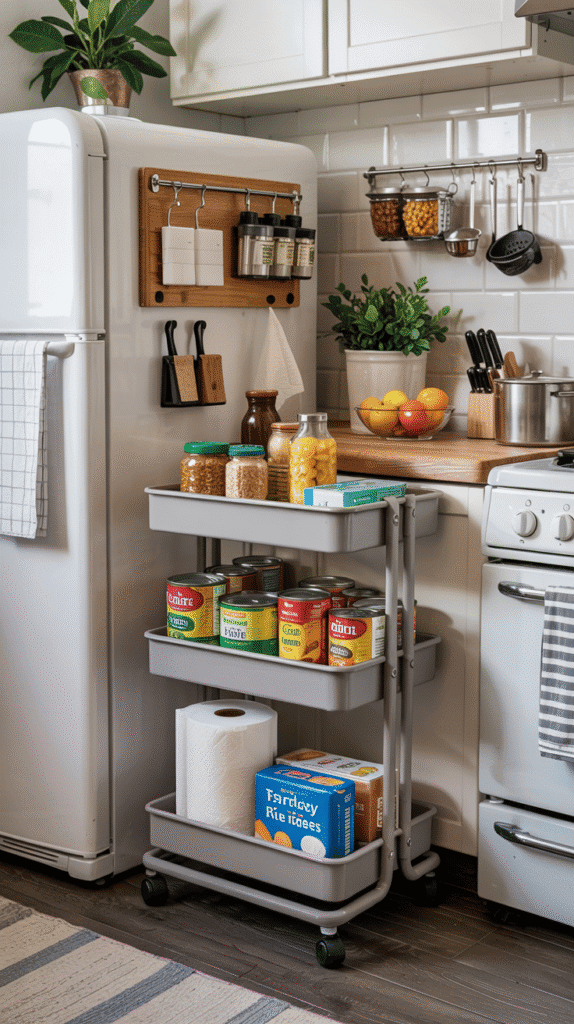
Those narrow spaces between your refrigerator and counter or between appliances? They’re perfect for slim rolling carts that slide right out when you need them. I call mine my “secret storage” because guests never notice it until I roll it out loaded with supplies.
My slim cart is only about 6 inches wide but holds an impressive amount of stuff: canned goods, cleaning supplies, extra paper towels, and all those random kitchen items that don’t have obvious homes. The top shelf holds items I use frequently, while the bottom shelves store backup supplies and things I only need occasionally.
The wheels are crucial—make sure they’re sturdy enough to handle the weight when the cart’s fully loaded. I learned this the hard way when my first cheap cart’s wheels gave out, sending a cascade of canned tomatoes across my kitchen floor. Now I invest in carts with quality casters that roll smoothly and lock in place when needed.
14. Ceiling-Mounted Pot Racks

Ceiling-mounted pot racks are dramatic, functional, and perfect for freeing up tons of cabinet space. Yes, they make a statement, but if you have the ceiling height and don’t mind your cookware being on display, they’re incredibly practical.
I installed a rectangular rack above my island, and it holds all my frequently used pots and pans. The key is choosing a rack that fits your kitchen’s style—mine’s a simple black iron design that matches my cabinet hardware. The installation required finding ceiling joists, which was trickier than I expected, but totally worth it for the storage space I gained.
Here’s the thing about pot racks: they work best when you have cookware worth displaying. If your pots and pans are mismatched or looking rough, you might want to invest in a coordinated set first. Also, be prepared for some extra cleaning—hanging pots collect dust and cooking grease more than ones stored in cabinets. But honestly, the convenience of having everything within arm’s reach makes the extra maintenance worthwhile.
15. Fold-Down Wall Tables
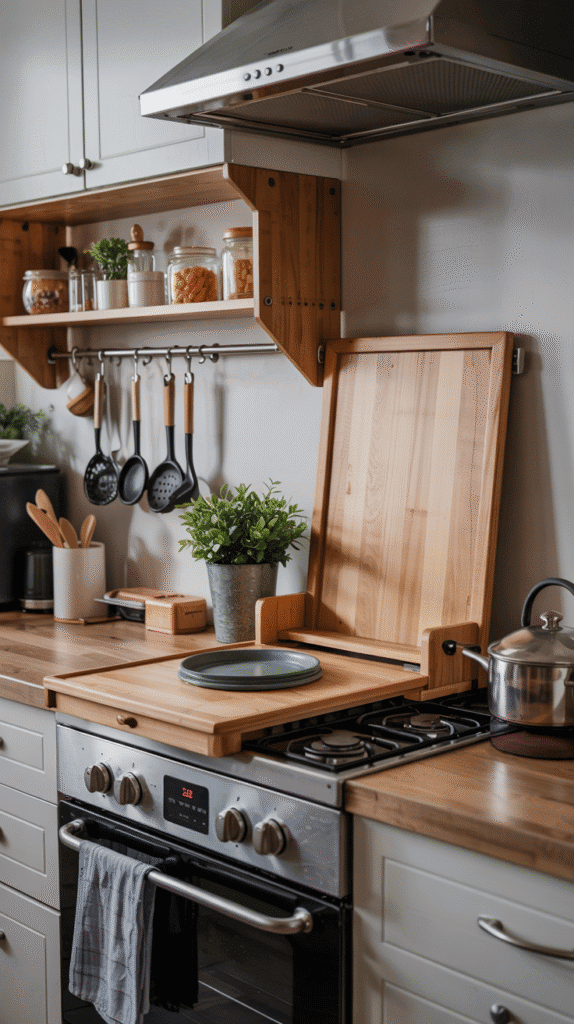
Fold-down wall-mounted tables are like having extra counter space that disappears when you don’t need it. These space-saving surfaces can serve as prep areas, dining spots for quick meals, or even temporary workspaces for non-cooking projects.
I have a small fold-down table mounted to the wall next to my stove. When I’m cooking complex meals that require lots of prep, I fold it down for extra workspace. When I’m done, it folds flat against the wall and barely takes up any visual space. The whole thing is about as thick as a picture frame when folded up.
Installation requires finding wall studs and using proper brackets—this isn’t something you want falling down mid-chop. I used heavy-duty hinges rated for the weight I planned to put on the table. Some models come with built-in supports that fold down with the table, while others require separate leg supports. Either way, make sure the mechanism operates smoothly and locks securely in both positions.
Making It All Work Together
The magic happens when you combine multiple hacks instead of relying on just one solution. My kitchen uses about 10 of these strategies, and they work together to create a space that’s both functional and clutter-free. The magnetic strips hold my knives, the under-cabinet baskets store my produce, the rolling cart provides mobile prep space, and the pull-out drawers make everything accessible.
Start with the problems that bug you most. Is it the pile of mail on your counter? Install a wall-mounted organizer with mail slots. Can’t find your spices? Try the inside-door racks or corner lazy Susan. The key is implementing solutions gradually so you can see what works best for your cooking style and space.
Don’t try to overhaul everything at once—that’s a recipe for frustration and buyer’s remorse. Pick 2-3 hacks that address your biggest pain points, live with them for a few weeks, then add more as needed. Your kitchen didn’t get cluttered overnight, and it won’t get organized overnight either. But with these strategies, you’ll be amazed how much counter space you can reclaim.
Remember, the best organizational system is the one you’ll actually use. Choose solutions that fit your lifestyle, not just ones that look good in photos. Your kitchen should work for you, not against you. Now go forth and reclaim those counters—your future cooking self will thank you!

This post shows 15 Hacks for Small Kitchen Counter Organization!



